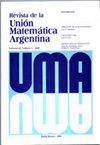A tribute to Pola Harboure: Isoperimetric inequalities and the HMS extrapolation theorem
IF 0.6
4区 数学
Q3 MATHEMATICS
引用次数: 1
Abstract
We give a simpler proof of the Gagliardo estimate with a measure obtained by Franchi, Pérez, and Wheeden [Proc. London Math. Soc. (3) 80 no. 3 (2000), 665–689], and improved by Pérez and Rela [Trans. Amer. Math. Soc. 372 no. 9 (2019), 6087–6133]. This result will be further improved using fractional Poincaré type inequalities with the extra bonus of Bourgain– Brezis–Mironescu as done by Hurri-Syrjänen, Mart́ınez-Perales, Pérez, and Vähäkangas [Internat. Math. Res. Notices (2022), rnac246] with a new argument. This will be used with the HMS extrapolation theorem to get Lp type result. 1. The isoperimetric inequality and extrapolation theory It is a great pleasure for us to dedicate this article to Eleonor Harboure, Pola, who played a central role in the development of modern Harmonic Analysis in Argentina. The first author is deeply grateful for her kind support during early stages of his career. Both authors want to stress how influential the work of Pola was to the mathematical community. This paper is also a tribute to the extrapolation theorem of Pola, R. Maćıas, and C. Segovia which was published in the American Journal of Mathematics [21] (see also [20]). See Theorem 2.1 in Section 2 for an updated version. We will refer to it as the HMS extrapolation theorem. Thanks to this result we can complete some of the main results obtained in [32] in the classical setting. A fractional counterpart with the Bourgain–Brezis–Mironescu gain will be obtained in the line of results as derived in [22] or [3]. The HMS extrapolation theorem was inspired by the classical extrapolation theorem of Rubio de Francia [8, 10,18]. 2020 Mathematics Subject Classification. Primary 42B25; Secondary 42B20. C. P. was supported by grant PID2020-113156GB-I00, Spanish Government; by the Basque Government through grant IT1615-22 and the BERC 2014-2017 program; and by BCAM Severo Ochoa accreditation SEV-2013-0323, Spanish Government. He is also very grateful to the MittagLeffler Institute under the program “Geometric aspects of nonlinear partial differential equations” where part of this research was carried out. E. R. was supported the projects PICT 2019-03968, PICT 2018-3399 and UBACyT 20020190200230BA. He is also very grateful to the suuport from Guandgdong Technion Israel Institute of Technology where part of this research was carried out.向波拉港致敬:等周不等式和HMS外推定理
本文章由计算机程序翻译,如有差异,请以英文原文为准。
求助全文
约1分钟内获得全文
求助全文
来源期刊

Revista De La Union Matematica Argentina
MATHEMATICS, APPLIED-MATHEMATICS
CiteScore
0.70
自引率
0.00%
发文量
39
审稿时长
>12 weeks
期刊介绍:
Revista de la Unión Matemática Argentina is an open access journal, free of charge for both authors and readers. We publish original research articles in all areas of pure and applied mathematics.
 求助内容:
求助内容: 应助结果提醒方式:
应助结果提醒方式:


